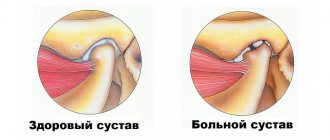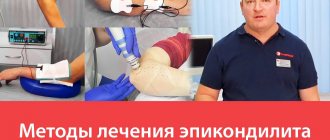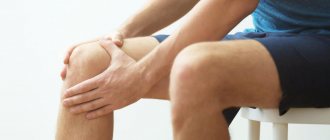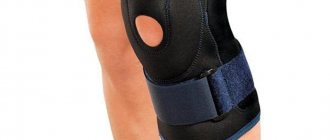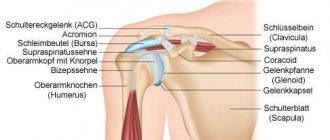Elbow bursitis
is an inflammatory process of aseptic or infectious type. The clinical picture of the diagnosed cases indicates the possibility of the disease occurring in both acute, subacute or chronic forms.
The most striking symptom of the presence of a pathological process is local compaction in the articulation area of the upper limb. The chronic form involves systematic pain (minor or moderate).
Diagnosis is carried out taking into account clinical manifestations, the degree of pain intensity, as well as the results of instrumental research methods.
What is elbow bursitis?
The disease in question is one of the most common types of inflammation of the joint and the accumulation of serous or purulent exudate (effusion) inside its cavity.
The development of most diagnosed cases is provoked by overloads and numerous microtraumas of the elbow. Among the patients there are athletes, people working in conditions of increased complexity (hard work), as well as those who, due to some characteristics, often rest their elbows on the table.
The risk group includes people of different ages, mostly young and middle-aged men.
The treatment plan is determined individually, taking into account the degree of intensity of symptoms, as well as the type of disease and clinical picture of a particular patient.
What could be the reason?
Most often, damage or heavy load is necessary for the disease to develop. Less commonly, the disease is part of a symptom complex of another, more serious pathology. Therefore the main reasons are:
- Trauma (bruise, awkward movement)
- Physical overload
- Friction (for example, constant support on the elbow (with inflammation of the olecranon bursa) or moving on all fours with damage to the patella
- Some rheumatological diseases (gout, ankylosing spondylitis)
Sometimes the cause cannot be determined.
Pathological anatomy of the disease
The cause of exacerbation of the symptomatic picture and the need for a therapeutic complex is inflammation of the bursa.
A bursa is a slit-type formation located relatively close to protruding bony areas, within which there is a relatively small amount of fluid.
The key function of the bursa is to cushion and protect the periarticular tissues from excessive pressure or excessive friction.
With systematic microtraumas, as well as increased pressure inside the joint, aseptic inflammation may occur, which will result in the active release of fluid from the bursa membrane. Depending on the amount of fluid produced, local swelling appears, caused by protrusion of the filled cavity.
Bursitis is the main thing
This is an inflammation of the bursa (bursa), a special protective structure of the joint. It has a fairly strong shell on the outside, consisting of connective tissue fibers. It serves to cushion the joint and protect the joint from external influences - shocks, injuries. The inner surface contains cells that secrete synovial fluid - a special lubricant to improve gliding in the joint and prevent wear of the heads of the bones. The second important function of intra-articular fluid is the nutrition of cartilage and bone tissues, which do not have their own blood vessels, and the necessary microelements are obtained from the lubricating fluid.
The elbow is a common place where this pathology occurs. This is a complex joint with a high intensity of movement and load and three joint capsules, each of which can be inflamed.
During the inflammatory process, the fluid in the joint increases in volume, its composition changes - it contains more protein, calcium salts, traces of blood and pus appear (with purulent inflammation). The elbow swells, movement in it becomes painful, limited, and performance is impaired.
Classification
Specialists involved in the diagnosis and treatment of elbow bursitis have created a classification that allows you to select the most effective treatment plan. Let us consider the types of inflammation of the hand joint according to various criteria in more detail.
Bursitis is classified according to the location of the pathological process:
- subcutaneous ulna;
- radioulnar;
- interosseous.
Depending on the characteristics of the course of the disease, three forms are distinguished:
- acute;
- subacute;
- chronic.
The type of illness is also determined by the nature of the inflammatory fluid. So, inflammation is isolated:
- serous;
- hemorrhagic;
- fibrinous;
- purulent.
And as the last classification criterion, the type of pathogenic microorganisms is determined, according to which two groups of infected elbow inflammation are distinguished:
- nonspecific (caused by staphylococcus or streptococcus);
- specific (caused by spirochete pallidum, tuberculosis microbacteria, as well as gonococci and other pathogens).
The most difficult to treat is purulent bursitis of the elbow joint, in which it is difficult to avoid surgical intervention.
What happens if acute bursitis is not treated?
The appearance of protrusion and pain should be a reason to consult a doctor. If treatment is not started in time, bursitis can become more complicated:
- development of an acute purulent process, infection of surrounding tissues, phlegmon;
- development of arthritis with subsequent decrease in limb function;
- the acute course will turn into chronic with constant pain that forces you to leave your profession or sports.
We combine proven techniques of the East and innovative methods of Western medicine
Read more about our unique method of treating bursitis
Causes of elbow bursitis
Like any other pathological condition of the human body, the disease in question is provoked by various types of reasons.
The causes of bursitis of the elbow joint can be determined by various types of factors and prerequisites, which are usually included:
- previous injury (bruise)
– the negative impact of optimal force on the tip of the elbow can provoke fluid secretion, inflammation and local swelling;
- Providing long-term impact (support on a hard surface, etc.)
– constant pressure can cause swelling, which will provoke the development of pathological processes;
- infection
– in a situation where an infection enters the body through damage to the skin, certain consequences may occur, including inflammation of the joint cavity;
- development of concomitant diseases
– illnesses associated with multiple lesions can cause an unwanted inflammatory process.
Why and how acute bursitis develops
To understand how bursitis differs from arthritis, you need to know the anatomy and physiology of the osteoarticular system. Each joint is surrounded by a joint capsule. Its inflammation is called arthritis. But besides this bag, there are others located next to the bone of the joint, surrounded by a synovial membrane and capsule, which help the tissues slide relative to each other. These synovial bursae (bursae) are closed in nature and act as shock absorbers. If an inflammatory process develops in the bursa, it is called bursitis. When the inner lining of the bursa, which secretes fluid, becomes inflamed, the permeability of the walls of its vessels increases, the fluid collects in the bursa, causing characteristic swelling and increase in volume (protrusion).
The cause of inflammation is open and closed injuries. The inflammation is sterile or infectious in nature. Very often, sterile (without infection) becomes infectious when infection penetrates into the site of inflammation through the skin or with blood from other organs and tissues.
Sometimes bursitis is secondary, developing against the background of an existing infection (tuberculosis, brucellosis, etc.)
Risk group
People at risk for developing this type of pathology include:
- who are forced to monotonously repeat mechanical actions characteristic of a certain professional specificity;
- whose life is closely connected with sports activities that involve repetition of movements;
- those suffering from pathologies of the respiratory system, which forces them to lean on their elbows to facilitate the flow of air into the lungs.
Symptoms of elbow bursitis
Before understanding the type of disease present and forming an idea of the upcoming treatment plan, it is necessary to have an idea of the symptomatic picture.
Symptoms of elbow bursitis include:
- local swelling and increased skin temperature
– the first and one of the main symptoms of pathology (“bump” the size of a goose egg);
- pain syndrome of varying degrees of intensity
– the stronger the swelling, the brighter and more intense the pain, which intensifies with pressure on the inflamed area or flexion/extension of the limb;
- visual changes
– with the development of an active inflammatory process, the affected area acquires a reddish tint;
- limited mobility
– the range of motion does not change, but performing a number of them may be difficult due to pain.
It is important to note that acute forms can cause severe pain in a situation where the articulation cavity is transformed in the process of movement. Symptoms may be vague.
When a relapse occurs, there is pain and limited mobility for a period of several days to several weeks.
Symptoms
Normally, a person cannot feel or see the bursa. If inflammation of the olecranon bursa occurs, then thickening of the skin and swelling appears on the back of the elbow. The bursa can also be filled with fluid and then appear as a small, soft ball - a bit like a cyst. In most cases (non-infected bursitis and not associated with arthritis), elbow bursitis is painless or slightly painful. Movement in the elbow joint is not impaired.
If the bursa is infected (“septic” olecranon bursitis), pain, redness, and tenderness in the elbow typically develop.
Bursitis associated with arthritis may not be painful in itself, but there may be joint pain due to arthritis. Patients with olecranon bursitis usually experience pain and swelling at the back of the elbow. The pain is usually worse when leaning on the elbow or when bending or straightening the elbow. In less severe cases, patients may experience only pain and stiffness in the elbow at rest after activities such as carrying a bag. Additionally, activities such as using a hammer or straightening the elbow against resistance can also cause pain in the initial stages.
As it progresses, patients may experience symptoms that increase during sports or physical activity. Patients may notice swelling and a large ridge above the ulnar prominence. Most patients with olecranon bursitis experience pain when the olecranon is touched. Sometimes small lumps can be felt in the area of the olecranon. Patients may also experience weakness in the elbow, especially when trying to straighten the elbow against resistance.
Which doctor should I contact if symptoms of elbow bursitis appear?
In a situation where one or several symptoms of elbow bursitis are observed, the time comes to find the answer to the question “Who should I turn to for help?”
Diagnosis and treatment can be carried out by several specialists, which include:
- therapist (primary superficial diagnosis and referral to a specialist);
- orthopedist-traumatologist (initial examination and development of a treatment plan);
- rheumatologist (providing professional assistance if clinical data consistent with inflammatory arthropathy);
- orthopedic surgeon (if, in parallel with the inflammatory process, there is a crack or immediate surgical intervention is required).
Based on the results of seeking medical help, the need for hospitalization in a hospital is determined, indications for which may include exacerbation of septic bursitis, aggravation of the pathology by concomitant infections, as well as the lack of a positive effect from the treatment already completed.
Modern approaches to the treatment of bursitis (recommendations for an outpatient surgeon)
For citation. Akhtyamova N.E. Modern approaches to the treatment of bursitis (recommendations for an outpatient surgeon) // RMZh. 2021. No. 3. pp. 193–196.
Pathological processes in extra-articular soft tissues (skeletal muscles, tendons and their synovial sheaths, fascia, aponeuroses, synovial bursae) constitute a large group of pain syndromes of the musculoskeletal system and are united under the name “diseases of soft periarticular tissues” [1–4].
Diseases of soft periarticular tissues are very common, and currently there is a tendency towards a further increase in the incidence of this nosology. According to literature data, in a survey of 6000 people, lesions of periarticular soft tissues are detected in 8% of individuals. At least 25–30% of patients seeking outpatient medical care from surgeons, traumatologists, neurologists, and rheumatologists are patients with lesions of soft periarticular tissues [3, 4]. Pathological changes in the periarticular soft tissues can be a manifestation of both local and systemic disease. Most often, damage to extra-articular tissues is local in nature in the form of bursitis, tendinitis, tenosynovitis, tendovaginitis, enthesitis, fasciitis - due to local overloads, microtraumas and overstrain, especially against the background of congenital or acquired skeletal anomalies, such as scoliosis and kyphosis of the spine, hypermobility syndrome, axial bone deformations, etc. [3, 4]. On the other hand, extra-articular lesions can be one of the manifestations of systemic diseases, including inflammatory (rheumatoid arthritis, seronegative spondyloarthritis), endocrine (diabetes mellitus, hypothyroidism), metabolic (gout, hyperlipidemia, etc.) [1]. The structure of diseases of extra-articular soft tissues is represented by more than 50 independent nosological forms, among which lesions of the tendon-ligamentous apparatus, called diseases of periarticular soft tissues, prevail: periarthritis, enthesopathies, tendonitis, tendovaginitis, ligamentitis, bursitis, etc. [1]. Despite the high prevalence and variety of forms of damage, there is still no unity in terminology, methods of examining patients and criteria for diagnosing soft tissue diseases. Various options for systematizing lesions of extra-articular soft tissues were proposed: diseases were grouped according to anatomical, etiopathogenetic principles, clinical manifestations, etc. Classification and systematization of nosologies is necessary in order to improve diagnosis. The most reasonable systematization of lesions of periarticular soft tissues according to the anatomical and functional principle seems to be most reasonable. According to this principle, all lesions of periarticular soft tissues can be combined into 4 groups [2]. I. Muscle diseases
1.1.
Inflammatory muscle diseases – myositis 1.2. Non-inflammatory muscle diseases – myopathies 1.2.1. Reactive 1.2.2. Metabolic 1.2.3. Endocrine 1.2.4. Vascular 1.2.5. Toxic II.
Lesions of fibrous and synovial formations 2.1.
Tendinitis 2.2. Tenosynovitis and tenosynovitis 2.3. Bursitis 2.4. Ligamentitis – tunnel syndromes 2.5. Fasciitis and aponeurositis 2.6. Combined forms of damage - periarthritis 2.7. Combined forms of damage III.
Diseases of subcutaneous fat tissue 3.1.
Erythema nodosum 3.2. Painful lipomatosis - Dercum's syndrome 3.3. Panniculitis IV.
Primary fibromyalgia Despite the high prevalence of the disease, the variety of nosological forms and the high level of disability caused by the pathology of extra-articular soft tissues, to date this problem has received undeservedly little attention. One of the most common nosological forms of damage to periarticular soft tissues is bursitis. The proportion of this pathology in the general structure of diseases of the musculoskeletal system is very high, therefore this pathology attracts the close attention of specialists. Ideas about it have changed and been supplemented as a result of recent research. Often, bursitis was rightly considered a typical pathology of representatives of certain professions, which determine the localization of the process: the elbow joints are more often affected by tanners, engravers, polishers, and embossers; knee - for tilers, parquet workers, miners; shoulder - for blacksmiths, loaders; bursitis of the anterior surface of the scapula - in diggers and sawyers; calcaneal bursitis – among sellers and ballerinas [5–7]. However, occupational bursitis is only part of the problem of pathological processes faced by doctors in both outpatient and inpatient practice. According to modern concepts, the key factor in the development of bursitis is mechanical damage to the periarticular bursa, less often - infection, metabolic disorders, intoxication, allergic reactions, autoimmune processes. Mechanical damage may be associated with excessive load or a decrease in tolerance to the previous load with age-related changes [8]. Mechanical load on the synovial bursa leads to an increase in the production of synovial fluid, thereby providing the necessary shock absorption of the structural elements. The structure of the synovial bursa is favorable for the development of inflammation. It is a narrow slit-like cavity lined with synovial membrane, delimited from surrounding tissues by a capsule and filled with synovial fluid. Such features ensure the attachment of an infectious component and the formation of inflammatory infiltrates. Synovial macrophages play a key role in the formation of the immune response and can be activated by a variety of proinflammatory factors, so constant antigenic stimulation of the synovium can contribute to the development of chronic bursitis [5, 8, 9]. In clinical practice, there are classifications of bursitis of different causes [5]: • taking into account the location (elbow, knee, shoulder joint, etc.) and the name of the affected bursa; • depending on the clinical course: acute, subacute, chronic bursitis; • aseptic (non-infected) and infected bursitis; • taking into account the pathogen: specific (for syphilis, tuberculosis, brucellosis, gonorrhea) and nonspecific bursitis; • according to the nature of the exudate: serous (plasma mixed with a small amount of blood cells), purulent (microorganisms, destroyed cells, disintegrated leukocytes), hemorrhagic (liquid with a large number of red blood cells) and fibrinous (high fibrin content) bursitis. The clinical manifestations of bursitis are determined by the peculiarities of the structure and function of the joint around which the synovial bursae are located. The leading symptom of bursitis is a round, fluctuating swelling that appears at the site of the lesion, painful on palpation, with symptoms of local hyperthermia. In addition, clinically, bursitis is characterized by the presence of pain, which significantly reduces the quality of life of patients. In most cases, the duration of the disease is limited to one to two weeks and does not pose a serious danger to human health. However, with the addition of microbial flora and the further development of the inflammatory process, serous inflammation quickly turns into a purulent form. The spread of the purulent process to surrounding tissues can occur as a phlegmonous inflammation with necrosis of the bursa wall and the formation of subcutaneous and intermuscular phlegmon. In advanced cases, long-term non-healing fistulas form. The breakthrough of pus into the joint cavity leads to the development of purulent arthritis. The most common bursitis is the elbow bursae and the bursae of the shoulder, hip and knee joints, as well as the Achilles tendon area. Elbow bursitis in most cases is a consequence of chronic injury during sports or professional activities. In this case, the subcutaneous synovial bursa of the olecranon process is mainly affected, and less commonly, the radiobrachial synovial bursa of the lateral epicondyle [7, 8]. In the area of the shoulder joint, the most commonly affected bursae are those that do not communicate with the joint cavity - the subcutaneous acromial, subdeltoid and subacromial. Complaints boil down to pain during abduction and rotation of the upper limb. Bursitis of the subdeltoid bursa is especially painful [7, 10]. Bursitis in the hip joint is characterized by severity. The deep-lying iliopectineal bursa, located between the muscles and the joint capsule, as well as the superficial or deep synovial bursae in the area of the greater trochanter of the femur are more often affected by inflammation. Bursitis of these localizations is accompanied by pain in the hip joint, aggravated by walking, especially at the beginning of movement, and local pain on palpation in the greater trochanter. Active movements, especially external rotation and abduction, are acutely painful. Iliopsoas bursitis is associated with inflammation of the bursa located between the iliopsoas muscle and the anterior surface of the hip joint. The bursa is large and in some cases communicates with the joint cavity. When a significant amount of exudate accumulates in it, it can be detected in the groin in the form of a tumor-like formation. Bursitis is accompanied by pain in the hip joint. Compression of the femoral nerve by a stretched bursa can lead to pain and paresthesia in the thigh [8, 11]. The appearance of limited swelling in the area of the knee joint is observed when the synovial bursae are affected. Thus, in the popliteal region, a limited elastic formation may be detected, associated with inflammation of the semimembranosocnemius bursa (Baker's cyst). In some patients it reaches a large size and can spread to the lower leg. Limited swelling in the area of the patella is characteristic of prepatellar bursitis. The development of infrapatellar bursitis leads to the formation of a cyst-like formation that protrudes on either side of the patellar tendon. Foot anserine bursitis is an inflammation of the synovial bursae located in the area where the semitendinosus, sartorius, and gracilis tendons attach to the tibia. It is usually not accompanied by significant swelling, but causes pain during exercise and local tenderness upon palpation in the affected area [6, 8, 11, 12]. A consequence of heavy physical activity can be bursitis in the Achilles tendon area. Bursitis of this localization is accompanied by pain near the site of attachment of the Achilles tendon to the heel bone. Objectively, swelling, hyperemia of the skin, and local pain on palpation are determined in this area [11]. Particular attention should be paid to the timely treatment of bursitis, since the lack of effectiveness of treatment measures leads to long periods of disability, and in 35–50% of patients, according to literature data, to the frequent development of recurrent and chronic forms [1, 4, 5, 8, 9] . The consequence of this may be the occurrence of persistent functional disorders, which significantly limit physical activity, including ability to work, and have a negative impact on the quality of life of patients. A prerequisite for effective treatment of bursitis is the elimination of stress on the affected area. The nature of the load limitation depends on the severity of the disease and the location of the affected area. Traditionally, treatment of bursitis begins with the prescription of nonsteroidal anti-inflammatory drugs (NSAIDs) (Fig. 1). NSAIDs are included in the program of pathogenetic therapy of bursitis as one of the main components.
The mechanism of anti-inflammatory action of non-steroidal drugs is the same for all drugs in this group, based on inhibition of the synthesis of inflammatory mediators - prostaglandins due to inhibition of the activity of the enzyme cyclooxygenase (COX) [2, 8, 9]. Given the variety of existing drugs, choosing one of them can be difficult and requires attention to each individual case. The selection of NSAIDs is carried out empirically, taking into account the severity of the analgesic and anti-inflammatory effect, duration of action, and individual tolerance of the drug. If there is no effect within 5–7 days, the drug should be replaced with a non-steroidal agent of another chemical group (Table 1) [2].
Despite the variety of drugs, there is no ideal non-steroidal anti-inflammatory drug. Nevertheless, the results of the studies, as well as an assessment of the dynamics of the use of NSAIDs, make it possible to identify certain leaders. One of these drugs from the NSAID group is nimesulide (Nise®). Unlike most NSAIDs, nimesulide selectively inhibits the proinflammatory isoform of COX-2 and does not affect the physiological COX-1 [13]. It is the first selective COX-2 inhibitor synthesized [14]. Another advantage when prescribing nimesulide is its non-acidic origin (in the nimesulide molecule the carboxyl group is replaced by sulfonanilide), which provides additional protection of the gastrointestinal mucosa [14, 15]. The analgesic activity of nimesulide is close to that of indomethacin, diclofenac, and piroxicam. Nimesulide also has a number of pharmacological effects that are independent of COX-2 blockade. In particular, it suppresses the hyperproduction of the main pro-inflammatory cytokines (interleukin-6, TNF-), the phosphodiesterase-4 enzyme and thereby reduces the activity of macrophages and neutrophils, which play a fundamental role in the pathogenesis of the acute inflammatory reaction [14, 15]. According to the statement of the British professor K. Rainsford, “nimesulide is an NSAID that has analgesic, anti-inflammatory and antipyretic effects due to unique chemical and pharmacokinetic properties and has a multifactorial mechanism of action that goes beyond its selective inhibitory activity against the COX-2 enzyme” [16] . To enhance the therapeutic effect and quickly relieve inflammation and pain, it is important to use an integrated approach to treatment. It has been proven that the combined use of Nise tablets and Nise gel enhances the therapeutic effect and promotes rapid relief of pain and inflammation [17]. The base of the Nise gel is represented by isopropyl alcohol, which allows the active substance to quickly penetrate deep into the tissue, directly to the source of inflammation. And after 15 minutes, the medicine is almost completely absorbed from the surface of the skin and concentrated at the site of inflammation. The drug Nise® (nimesulide) is available in two forms - in the form of 100 mg tablets for oral use and in the form of a 1% gel for external local use [18]. Thus, the variety of forms of damage to extra-articular soft tissues, their high prevalence and social significance determine the relevance of the problem of diagnosis and treatment of bursitis. Timely and complete treatment helps to avoid the development of protracted and recurrent forms of the disease. Among the variety of NSAIDs that are the drugs of choice in the treatment of bursitis, nimesulide claims to be one of the first places in terms of treatment effectiveness. The combined use of oral and local forms of NSAIDs improves treatment results for persistent and severe disease.
Diagnostic features
The diagnostic process is based on a patient interview, clinical assessment of existing symptoms and, of course, direct examination. To clarify the suspected diagnosis, instrumental research methods are additionally used, including:
- radiographic examination
– the examination results allow us to exclude the possibility of a bone fracture or the presence of foreign bodies, salt deposits, etc.;
- ultrasonography
– forms an overall picture for visualizing the situation, allowing you to fully assess the condition of the walls and the volume of inflammatory fluid;
- magnetic resonance imaging (MRI)
– detailing the results obtained provides the opportunity to confirm/refute the diagnosis and exclude other assumptions;
- puncture
– sampling the contents of the cavity allows you to determine the type of fluid, which is of particular importance when making a diagnosis. It is important to note that during the collection of material for research, therapeutic manipulations may be carried out.
In addition, a number of additional laboratory tests are carried out (clinical and biochemical blood tests, detection of C-reactive protein and rheumatological tests), which makes it possible to verify the accuracy of the diagnosis and makes it possible to assess the severity of the existing pathological process.
Treatment of elbow bursitis
Treatment of bursitis of the elbow joint is determined exclusively on an individual basis, after a thorough diagnosis, taking into account the existing clinical picture and medical history of the patient.
As with any other ailment, the best results in the treatment process can only be achieved with an integrated approach, involving a combination of conservative agents and other techniques.
Let's look at the main methods of treating elbow bursitis in more detail.
Conservative treatment
Involves the use of medication. The impact can be provided by drugs of various forms, in particular, local effects.
Among the most prescribed groups of drugs are:
- NSAIDs (non-steroidal anti-inflammatory drugs) – reduce inflammation and relieve pain;
- antibiotics - help fight infections in the septic form;
- corticosteroids - intra-articular injections are especially effective in situations where you need to quickly and effectively eliminate pain;
- chondroprotectors – provide the opportunity to activate the process of tissue restoration.
Chondroprotectors are of particular importance in conservative treatment, promoting the restoration of affected tissues and improving functionality. Their use is also advisable during the period of remission, which gives additional confidence in maintaining a healthy elbow during a chronic disease. Artracam is considered to be one of the best drugs in this category.
Physiotherapy
The use of physiotherapeutic treatment methods accelerates the recovery of the functional abilities of the upper extremities and has a large number of other advantages. Among the most effective and widely used physiotherapeutic techniques are:
- attending massage sessions (course);
- exposure to the affected area with ultrasound/laser/electric current;
- phonophoresis.
The duration of courses of physiotherapeutic treatment is determined by the attending physician, taking into account the characteristics of the patient’s recovery process and the characteristics of the pathology.
Radical methods
Despite the fact that most cases of elbow disease do not require surgical treatment, radical methods of its treatment still exist and are used in situations where conservative therapy and physical treatment do not give the necessary result (more than 2 months of starting treatment or in situations where secondary pathologies form).
The most effective and used method of radical therapy is endoscopic excision of inflamed tissue, which belongs to the category of minimally invasive surgical interventions.
Treatment
In most cases, elbow bursitis can heal on its own by reducing the stress on the elbow. But in some cases, medical intervention, including surgery, is required.
Conservative treatment of elbow bursitis includes:
- Rest and change in activity. Patients with elbow bursitis should avoid activities that put pressure on the elbow. Wearing elbow pads can also help protect the elbow bursa from pressure or additional irritation.
- Cold. Applying a cold compress to a swollen elbow for 20 minutes two or three times a day can help relieve symptoms and reduce swelling.
- Compression. Using an elastic bandage wrapped around the affected joint can help reduce swelling.
- Elevation. Elevating the elbow to or above heart level reduces blood flow and thereby reduces inflammation.
Drug treatment. Nonsteroidal anti-inflammatory drugs such as aspirin, ibuprofen (such as Advil), naproxen (such as Aleve), and COX-2 inhibitors (such as Celebrex) can reduce swelling and inflammation and relieve pain associated with elbow bursitis.
Aspiration. Aspiration of the swollen bursa using a needle and syringe relieves the pressure immediately. Aspiration is also done to test the fluid for microbes. (A positive test would indicate septic bursitis).
Corticosteroid injections. Symptoms of bursitis can be significantly reduced with corticosteroid injections. Corticosteroids are powerful anti-inflammatory drugs, and injecting them directly into the inflamed bursa usually significantly reduces pain and swelling. However, corticosteroid injections have potential side effects such as infections and degeneration of the skin on the elbow. Thus, these injections are usually prescribed for persistent bursitis and other treatment is not effective.
Antibiotics. Septic olecranon bursitis requires antibiotics. The choice of antibiotic depends on the microorganism that is causing the infection (most often Staphylococcus aureus). For most people with septic bursitis, treatment with antibiotics is quite effective, with some requiring hospitalization and intravenous antibiotics.
Possible complications and prognosis of patients with diagnosed bursitis of the elbow joint
Like any other disease, ulnar bursitis has certain prognoses, which were formed thanks to a large number of cases of medical practice.
In the vast majority of cases, the development of pathology does not lead to serious restrictions on the mobility of the arms (mostly the joint).
In the absence of an infectious lesion, positive dynamics are observed in the near future after the start of complex treatment (in conjunction with a system of anti-inflammatory drug therapy).
However, it is important to say that in rare cases, a relapse may occur, in which even minor swelling and mild pain can trigger the release of a large amount of fluid.
Refusal of treatment or untimely assistance may aggravate the situation and complicate the treatment process.
Diagnosis of inflammation
The peculiarity of bursitis is that the doctor will be able to determine its type through palpation and a clarifying questioning of the patient. This form of diagnosis is standard.
For an in-depth diagnosis of inflammation, the patient is prescribed an x-ray. With its help, the doctor will be able to study the formation of osteophytes, the condition of the joint, and prescribe effective treatment.
In rare cases, specialists prescribe puncture of the synovial bursa. The method is necessary to diagnose the cause of the disease if the previous examination did not give accurate results.
Preventive measures
The best method of treating diseases is their timely prevention. To avoid having to experience the effectiveness of modern treatment methods, it is best to take preventive measures. Let's try to figure out what these include.
Disease Prevention
A number of simple recommendations will help prevent elbow bursitis, compliance with which will ensure the ability to maintain healthy joints and the overall level of quality of life:
- Preventing injuries, ensuring skin protection.
- Providing high-quality first aid for injuries to the skin or joint.
- Timely seeking medical help.
- Maintaining a healthy lifestyle.
- Quitting bad habits (smoking, drinking alcohol, overeating).
- Attending preventive medical examinations.
- Preventive use of a course of chondroprotectors like Artracam.
How to hold out until you see the doctor
With acute bursitis, patients may experience severe pain. To alleviate the condition, you can do the following yourself:
- apply a pressure bandage, being careful not to squeeze the tissue too much;
- fix the site of the lesion so that the limb is constantly at rest;
- if there is no purulent inflammation, the patient’s general condition does not suffer, then apply a warm compress; with elevated body temperature, swelling and hyperemia of the skin over the joints, it is better to apply cold
- give the limb an elevated position.
All this will only reduce the pain and allow you to wait for qualified assistance. Therefore, you should not postpone your visit to the doctor.
